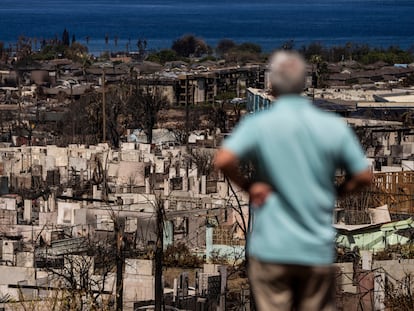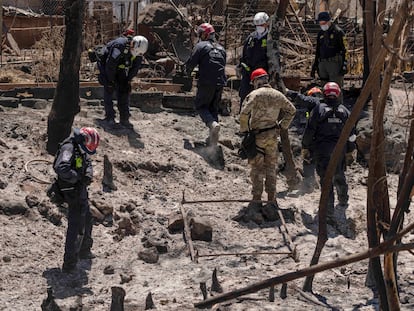The dark side of paradise: Maui wildfires devastate Hawaii’s vulnerable populations
Housing shortages, excessive dependence on tourism, serious social inequalities and long-standing grievances among the indigenous communities are just some of the major problems facing the archipelago


Columns of smoke still escape from the rubble of what was the town of Lahaina, days after the wildfires on the island of Maui reduced it to a handful of ashes.
The death toll rose to 114 after rescue teams completed their search through more than 60% of the burned area. The ancient capital of the kingdom of Hawaii now resembles a lunar landscape: a black space between the blue sea and the green mountain.
In the luxury tourism part of the area, sprinklers continue to irrigate an immaculate golf course. The fountains shoot out streams of water, as if nothing has happened.
Hawaii — and the island of Maui, in particular — is sold in movies and tourist brochures and as a tropical paradise. However, the Lahaina disaster — which has left thousands of people homeless and an unknown number missing — has exposed the serious problems that lie beneath this idyllic image. It has also reopened old wounds among the Native Hawaiian population, which laments how colonization — followed by tourism — has turned them into second-class citizens.
“Mauiikakai; Maui strong” are the words that someone has painted over the tunnel that marks the entrance to the west of the island, where Lahaina is located. This encouraging slogan has gone viral after the worst fire in the United States in more than a century. A couple of miles on, a traffic sign — put in place long before the fire — warns, to no avail: “Dry area. Avoid fires.”
The signs of the disaster start to become visible long before you reach the center of the town. There are tents on the beaches, where some of the displaced have sought refuge — there are burned cars, police vehicles blocking access. And, at the entrance to Lahaina, there’s a large aid distribution center in the parking lot of a strip mall, where lines of vehicles of displaced residents receive assistance: food, diapers, toiletries. Beyond that, police and army barriers prevent access to what used to be the urban center, now a plain of gray ashes and blackened rubble.
Windelle Aguinaldo — a cook of Filipino origin, born and raised in Lahaina — waits with her five-year-old daughter to receive a charger for her cellphone. The Federal Emergency Management Agency (FEMA) has just installed Aguinaldo and her family in a hotel room in the luxury area, as it has done with another thousand-or-so people. “We don’t know how long we can be there for,” she sighs. The governor of Hawaii, Josh Green, has ensured that the displaced will be able to stay as long as necessary, which he estimates to be between six and seven months. Like many others who have been left homeless, Aguinaldo has heard rumors of developers trying to buy cheap land from affected families.
“That would be terrifying. There was already a huge problem of homelessness — this could make it worse. It was normal for up to five families to live in the houses that have been lost. Where would those people go? They say that everything will be rebuilt, but it will take years. Many people will end up having to leave,” Aguinaldo predicts.
If her fears are fulfilled, this would continue a trend that had been going on for some time. Some of the 87,000 workers that make up Maui’s workforce have been moving to the continental United States, forced by the lack of job prospects — “Tourism, army or construction. There isn’t much else,” a resident summarized — and the high cost of living. Las Vegas, Nevada, is nicknamed “the ninth Hawaiian island,” due to its large community from the archipelago.
In addition to word of mouth, social media has been filled with warnings from members of the local community about potential speculators who want to acquire land in an area that attracts tourists, but is also key to Hawaiian history and identity.
That fear of gentrification touches a very sensitive nerve with the indigenous population. In 1893, a Washington-backed coup dethroned Queen Lli’uokalani and ultimately placed the land of the Hawaiian Kingdom — including the vast pineapple and sugar plantations that American businessmen had founded there — under the control of the United States. “Our family — like many others on Maui — was forced to sell our home. Tragedies like the Maui fires simply accelerate this trajectory,” lamented Kaniela Ing, a community organizer and former member of the Hawaii House of Representatives, on social media.
Plantations — unable to compete with cheaper products grown in other countries — eventually gave way to tourism at the end of the 20th century. This new sector became the great engine of the Hawaiian economy. Today, 80% of Maui’s annual wealth comes from visitors from outside the island. Hotels, apartment buildings and houses were built to meet the demand of continental American visitors and investors eager for second or third homes.
This process was exacerbated during the pandemic, when lockdowns and remote work suddenly made working from the beach an attractive and feasible option. Since 2019, the value of a square foot of property in Maui has gone up by 35%. As in other places where tourism dominates the economy, the local population finds itself pushed aside and pushed out.

Preferential treatment for tourists
In many cases, the perception is that tourists — especially those with deep pockets — receive favorable treatment compared to local residents, who feel like second-class citizens in their own land. They cite, among other things, the large amount of water consumed by luxury hotels — up to 500,000 gallons per day, considering that the average family home uses 400 gallons — while in times of drought, the local population (at least, those living in less-visited areas) sees their water consumption limited under the threat of fines. Before the recent fires, it wasn’t uncommon to see Hawaiian flags planted upside down along the island’s roads, in a symbol of protest against this policy.
Last week, images of a tour boat — which brought a group of snorkelers ashore about 11 miles from Lahaina — caused widespread outrage among evacuated residents and the indigenous community. “Do not travel to Maui,” Hawaiian actor Jason Momoa warned on Instagram. “Do not convince yourself that your presence is needed on an island that is suffering this deeply.”
In the destroyed town, local communities have organized in parallel to the operations of FEMA and other large aid organizations, in order to distribute aid to evacuees. Organized in a coalition, Lahaina civic associations are calling on Governor Green to take residents and their culture into account when planning what is expected to be a long and expensive rebuilding process. Washington has estimated the damage from the fire to be about $5.6 billion.
Lahaina residents need “time to heal,” but they also want to be part of the discussion about rebuilding needs, according to community organizer Keeaumoku Kapu. This past Friday, he participated in a joint statement given by the local coalition, on the outskirts of the burned-out city. “Give us time and the opportunity to participate in the recovery plans… be part of the solution and not the problem.”
That same day, the governor of Hawaii promised — during a televised address to the state — that the local community will be included in the reconstruction process. He also announced enhanced criminal penalties for those who try to take advantage of circumstances to buy cheap land from residents who have lost their homes. But he also maintained that no expense will be spared to rebuild a city as important to the island’s tourism economy as it is to the identity of Hawaiians. “Lahaina will rise again,” Green concluded.
Sign up for our weekly newsletter to get more English-language news coverage from EL PAÍS USA Edition
Tu suscripción se está usando en otro dispositivo
¿Quieres añadir otro usuario a tu suscripción?
Si continúas leyendo en este dispositivo, no se podrá leer en el otro.
FlechaTu suscripción se está usando en otro dispositivo y solo puedes acceder a EL PAÍS desde un dispositivo a la vez.
Si quieres compartir tu cuenta, cambia tu suscripción a la modalidad Premium, así podrás añadir otro usuario. Cada uno accederá con su propia cuenta de email, lo que os permitirá personalizar vuestra experiencia en EL PAÍS.
¿Tienes una suscripción de empresa? Accede aquí para contratar más cuentas.
En el caso de no saber quién está usando tu cuenta, te recomendamos cambiar tu contraseña aquí.
Si decides continuar compartiendo tu cuenta, este mensaje se mostrará en tu dispositivo y en el de la otra persona que está usando tu cuenta de forma indefinida, afectando a tu experiencia de lectura. Puedes consultar aquí los términos y condiciones de la suscripción digital.
More information
Archived In
Últimas noticias
Most viewed
- Reinhard Genzel, Nobel laureate in physics: ‘One-minute videos will never give you the truth’
- Oona Chaplin: ‘I told James Cameron that I was living in a treehouse and starting a permaculture project with a friend’
- Pablo Escobar’s hippos: A serious environmental problem, 40 years on
- Charles Dubouloz, mountaineering star, retires at 36 with a farewell tour inspired by Walter Bonatti
- Why we lost the habit of sleeping in two segments and how that changed our sense of time










































